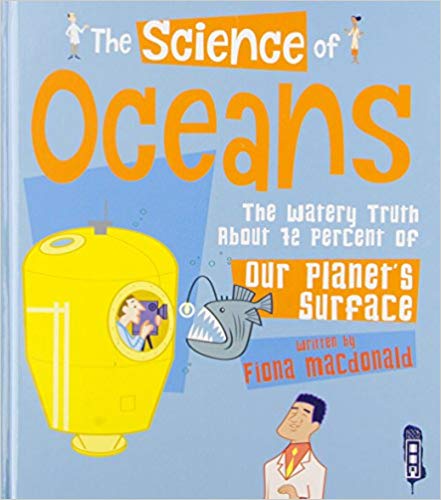-
The Science of Natural Disasters: The Devastating Truth About Volcanoes, Earthquakes and Tsunamis
Alex Woolf, Andy Rowland
Hardcover (Scribo, )None
-
The Science of Flight: The Air-mazing Truth About Planes and Helicopters
Ian Graham, Christos Skaltsas, Bryan Beach
Paperback (Franklin Watts, Feb. 1, 2019)Discover planes that can fly faster than the speed of sound!The Science of Engineering series feature different forms of architecture and transport engineering. Features include funny and interesting illustrations; real-world science examples; side panels to tackle complex subject matter in a fun and relevant way; detailed glossary and more.This book explores how our understanding of the science of flight has improved, creating aircraft that are bigger and faster than the Wright brothers ever dreamed of. It covers helicopters, jet-planes, rocket-planes, planes big enough to carry hundreds of people, planes that can fly faster than the speed of sound, and even flying machines small enough to strap on your back. W
W
-
The Science of Seafaring: The Float-tastic Facts About Ships
Anne Rooney, Alexandre Affonso, Bryan Beach
Paperback (Franklin Watts, Feb. 1, 2019)Explore how methods of moving over the sea have changed through the centuries.The Science of Engineering series feature different forms of architecture and transport engineering. Features include funny and interesting illustrations; real-world science examples; side panels to tackle complex subject matter in a fun and relevant way; detailed glossary and more.This fascinating guide to the science of seafaring explores how methods of moving over the sea have changed through the centuries, from using oars and simple sails to huge nuclear powered ships. It covers how technology has allowed us to stay afloat, navigate, move through water, and survive bad weather - and even go below the surface, as in the iconic submarine. W
W
-
The Science of Natural Disasters: The Devastating Truth About Volcanoes, Earthquakes, and Tsunamis
Alex Woolf, Andy Rowland
Paperback (Franklin Watts, Feb. 1, 2018)From earthquakes to volcanoes, it is an eye-opening introduction to the devastating and often terrifying power of the natural world and how science can be used to predict disasters and help prevent loss of life.Our planet can be violent and destructive. Volcanoes erupt, sending out clouds of ash and rivers of molten lava. Earthquakes shake up the land, destroying buildings and sparking destructive fires. Tsunamis-enormous ocean waves-crash onto the shore, devastating coastal communities.This fascinating guide to natural disasters combines fact-packed, easy-to-read text with colorful and quirky illustrations. W
W
-
The Science of Bridges and Tunnels: The Art of Engineering
Ian Graham, Diego Vaisberg, Bryan Beach
Paperback (Franklin Watts, Feb. 1, 2019)Discover the laws of nature that apply to bridges and tunnels.The Science of Engineering series feature different forms of architecture and transport engineering. Features include funny and interesting illustrations; real-world science examples; side panels to tackle complex subject matter in a fun and relevant way; detailed glossary and more.Over time, scientists and engineers began to understand the laws of nature that apply to bridges and tunnels. They understood the strengths and weaknesses of materials better, too - and began to create new ones, like concrete and steel. This fascinating guide to bridges and tunnels explores unique examples of each, what they're made of, and all of the unexpected twists and turns taken in their development. W
W
-
Sid the Science Kid: Hooray for Rain!
Annie Auerbach
Paperback (Festival, Jan. 1, 2020)None J
J
-
The Science of Oceans: The Watery Truth about 71% of Our Planet's Surface
Fiona Macdonald, Bryan Beach
Hardcover (Scribo, )None
-
Science in Ancient Mesopotamia
Carol Moss
Library Binding (Franklin Watts, Sept. 1, 1998)Describes the enormous accomplishments of the Sumerians and Babylonians of ancient Mesopotamia in every scientific area, a heritage which affects our own everyday lives U
U
-
What Is Migration?
John Crossingham, Bobbie Kalman
Paperback (Crabtree Pub Co, Oct. 31, 2001)A simple presentation of the migratory habits of such animals as geese, eels, and frogs and toads. N
N
-
The Science of a Piece of Paper
Camilla de la Bedoyere
Library Binding (Gareth Stevens Pub Learning library, Jan. 1, 2009)An innovative series with engaging sidebars, colorful photography, and labeled diagrams uses familiar, everyday objects to present science concepts such as sound, motion, states of matter, and other science curriculum topics. W
W
-
Science in Ancient Greece
Kathlyn Gay
Library Binding (Franklin Watts, Sept. 1, 1998)Discusses the theories of ancient Greek philosopher-scientists such as Hippocrates, Aristotle, and Pythagoras U
U
-
What is a Whale?
Bobbie Levigne Kalman
Paperback (Crabtree Publishing Company, Jan. 1, 2000)The Science of Living Things series helps children understand that they are as connected to trees, rocks, and weather as the animals that live outdoors! This important series helps define the basic concept of life and investigates the incredible world of living things. Each book explores a basic scientific concept or animal using: -- easy-to-understand text-- clearly labeled diagrams-- exciting, full-color photographsWhales are the only mammals that spend their entire life in the water. From playful dolphins to enormous blue whales, the behavior, habitats, and physiology of these amazing marine mammals are explored in What is a Whale? Spectacular full-color photos help show: -- flukes, flippers, and fins-- the whale family tree-- baleen and toothed whales-- how whales communicate through echolocation-- watery homes and what they eat-- baby whales-- whale-watching and why whales are in danger O
O